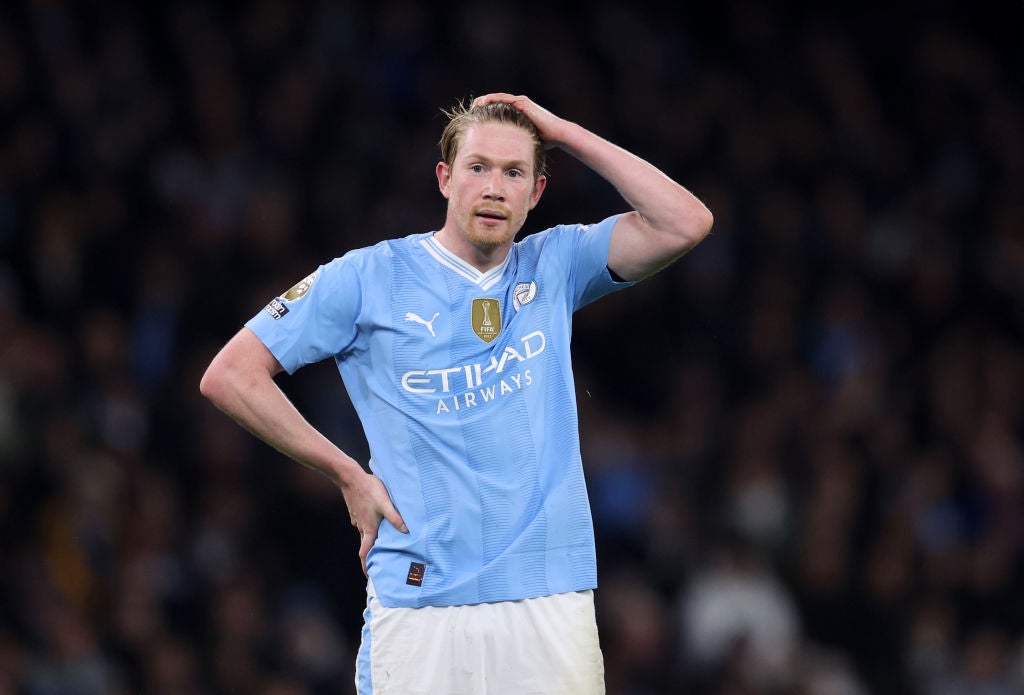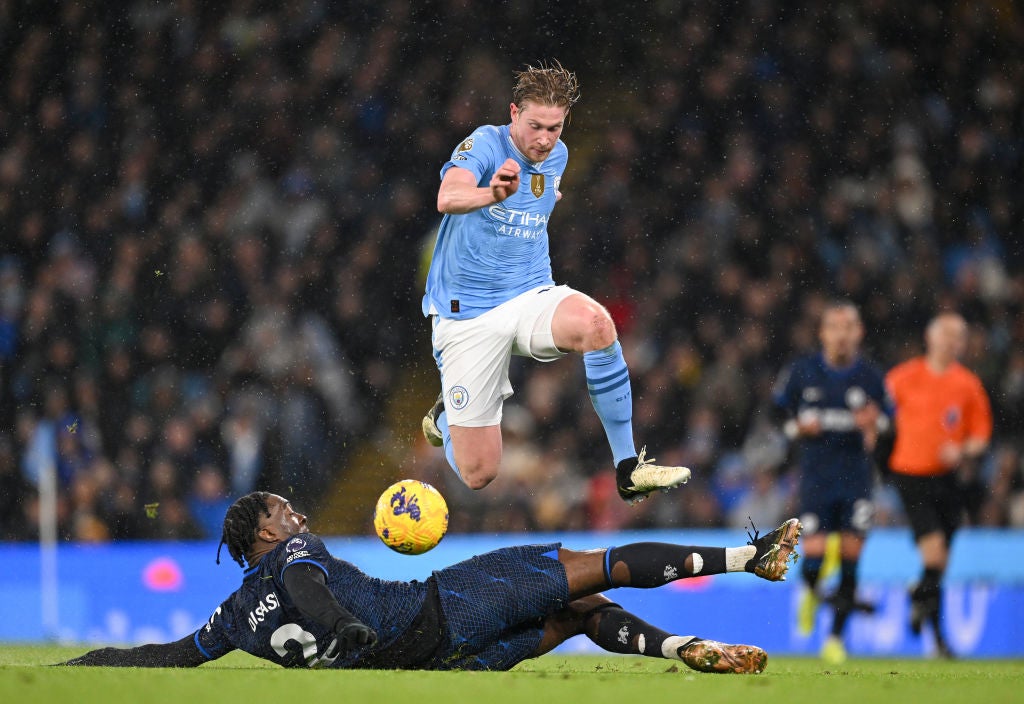Kevin De Bruyne’s new role exposes cracks in Manchester City’s midfield
As the brilliant Belgian has been pushed further forward by Pep Guardiola, the champions were left too open in Saturday’s 1-1 draw against Chelsea
Your support helps us to tell the story
From reproductive rights to climate change to Big Tech, The Independent is on the ground when the story is developing. Whether it's investigating the financials of Elon Musk's pro-Trump PAC or producing our latest documentary, 'The A Word', which shines a light on the American women fighting for reproductive rights, we know how important it is to parse out the facts from the messaging.
At such a critical moment in US history, we need reporters on the ground. Your donation allows us to keep sending journalists to speak to both sides of the story.
The Independent is trusted by Americans across the entire political spectrum. And unlike many other quality news outlets, we choose not to lock Americans out of our reporting and analysis with paywalls. We believe quality journalism should be available to everyone, paid for by those who can afford it.
Your support makes all the difference.When others go backwards, Kevin De Bruyne looks forwards. It can be a description of his passing, a risk-taker often eschewing the safe option in a quest to create. But it is true positionally, too: last season De Bruyne noted that, in the latter years of their careers, many an attack-minded midfielder has retreated into a deeper role. It was the case with Steven Gerrard, who went from a No 10 to a No 6. Frank Lampard and Cesc Fabregas were often found nearer the base of the midfield than the tip in their footballing dotage. Christian Eriksen spends more time nearer his own penalty box than he used to. Wayne Rooney was the forward who tried to reinvent himself as a midfielder.
Then there is De Bruyne, the midfielder who has become a quasi-forward, the No 10 who could double up as a No 6. Not any more. Pep Guardiola has ruled out using him as a more defensive midfielder. “No,” he said. “He has to be in the final third. He is not there to defend deeper. I want Kevin in the final third because his huge talent is there.”
That huge talent has rendered him versatile for much of his career: right winger at times, false nine, most notably in a Champions League final, he was the man who coined the phrase “free eight” and played the role better than anyone else. But there have been times when De Bruyne has shown the discipline to operate in a double pivot. His long-range passing means he can still unlock a defence from his own half.
But Guardiola was a very different type of holding midfielder; a European Cup winner as a player, he self-deprecatingly said on Saturday that he scored 11 goals in 11 years, whereas De Bruyne is two off a century in City colours alone. The Belgian’s best position has never entailed restraining and restricting him. Now, however, Guardiola sees him purely as an auxiliary attacker.

“When you attack the final third he can move with freedom [to the] right or left and make his incredible talent,” he explained. “But sometimes in the moments you have to defend. The role from Rodri or [Ilkay] Gundogan last season or Bernardo [Silva] or [Mateo] Kovacic this year, he has not.”
All of which was instructive, but perhaps also illustrated the faultlines in this City midfield and made them atypical for a Guardiola side. De Bruyne will never be a metronome in the manner of a quintessential Guardiola holding player. If he has the skills to be the quarterback, he is instead the trequartista. But it was notable that, on Saturday against Chelsea, when City could have benefited from a deeper De Bruyne, he instead operated in a more advanced role than Julian Alvarez, a World Cup-winning centre-forward.
He can seem a second striker: on Saturday, City almost played 4-2-4. If part of the thinking is to get Erling Haaland’s supplier-in-chief close to the Norwegian, it also utilises one of his greatest attributes: he put in 22 crosses, an absurd number, against Chelsea.
There is a logic to using him in the final third: De Bruyne has long been more productive than most forwards. There is an evolution, too: in 2021-22, he scored a career-best 19 goals, compensating when City lacked a specialist centre-forward. Last year, he registered 29 assists.
The problems come behind De Bruyne. Guardiola, the manager who has cherished and collected midfielders, can look suddenly short of them. This weekend, with neither Silva nor Kovacic fully fit, it felt Rodri was on his own, isolated amid the disappearance of the rest of the midfield. He doubled up as the scorer, extending his own unbeaten run – he has not lost a club game for over a year – with an equaliser.

Yet his is a huge burden. Kovacic is injury prone. Kalvin Phillips is exiled, sent off as his almost comically bad West Ham career took another wrong turn. Matheus Nunes was benched, in another vote of no confidence. Alvarez tries but is not really a midfielder. Manuel Akanji struggled in the hybrid role of defender and midfielder that it feels increasingly apparent that only John Stones can really play.
A theme of City’s season is that they miss Gundogan: in so many ways, but including his ability to knit together play with his passes, to operate behind the ball and not just as a box-crashing goalscorer, to play in a duo with Rodri when required. If De Bruyne is no longer a deeper option, that is exacerbated.
City could do with two Silvas in their squad: the Portuguese may be both Guardiola’s preferred choice on the right wing and alongside Rodri. “The best midfielder in the world by far,” said Guardiola; that was no slight on De Bruyne, a de facto forward for him now.
On Saturday, with the Belgian in the final third, City were too open in transition and lacked their usual control. And if Rodri is the world’s best midfielder, he was City’s one-man midfield.



Join our commenting forum
Join thought-provoking conversations, follow other Independent readers and see their replies
Comments